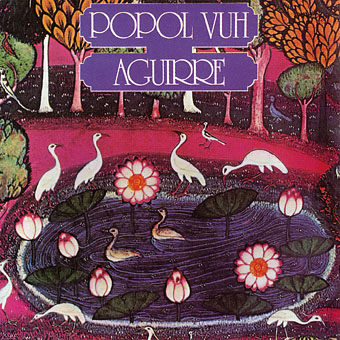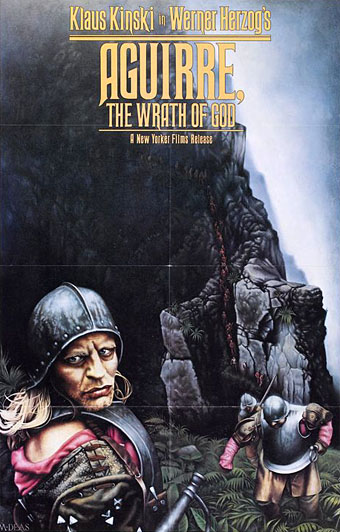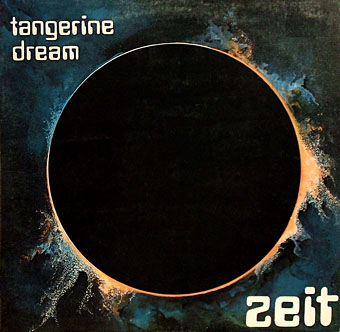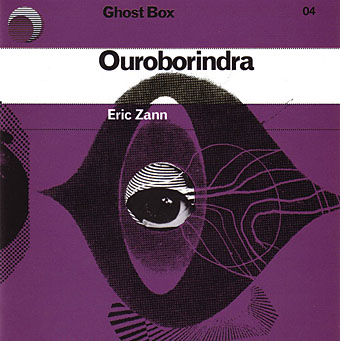Design by Sawyer Studios, painting by Michael J Deas.
If you’re a music obsessive d’un certain âge it’s a common thing to get bees in your bonnet about the reissues of favourite albums. For Krautrock aficionados the reissues of Popol Vuh‘s releases have been more frustrating than most. Aguirre was the band’s seventh album released in 1976, four years after Werner Herzog’s film, Aguirre, The Wrath of God, for which the group provided a score and from which the album borrows its title.
The album isn’t quite a soundtrack—although it contains a snatch of ethnic music from the film and a recurrent theme—and it’s also less of a whole than the albums which preceded and followed it. The film’s ethereal title theme was played by Florian Fricke on a “choir-organ“, a mysterious Mellotron-like instrument which had previously been employed by Amon Düül II. The rest of the album was fleshed out with variations on tracks from earlier Popol Vuh releases, none of which are used in the film. Side 2 of the vinyl edition featured a single track entitled Vergegenwärtigung (Visualisation) which is also absent from the film and whose doomy ambience would have been more suited to Herzog’s later Nosferatu the Vampyre. This lengthy piece is a drifting slab of drone-werk which would have been recorded in the early 1970s when Florian still had his enormous Moog synth. It’s probably the most minimal thing in the whole Krautrock canon, sounding at times like a lost fifth track from Zeit, Tangerine Dream’s collection of drones which featured Florian as a guest performer. As such Vergegenwärtigung is an overlooked, if minor, piece of Kosmische electronica which has only ever been available on vinyl. And there, dear reader, is the rub.

No designer credited but it was probably Peter Geitner.
The various CD reissues of the album added and removed tracks from the band’s catalogue seemingly at random. I have the Spalax reissue which featured the film’s title theme then nothing else from the original album, the following tracks being the entirety of Popol Vuh’s second album, In Den Gärten Pharaos, and a beautiful solo piano suite, Spirit of Peace. Yes, it’s nice to have them there but, you know…it’s not Aguirre! When a Japanese edition appeared in 2006 the track they call Vergegenwärtigung turned out to be the errant electronic piece with additional pieces of music layered over it for no apparent reason. The Japanese are usually very good with CD reissues so this was a particular disappointment. After many years of living with a ruined vinyl copy of the album it was gratifying this weekend to find an mp3 of the original of Vergegenwärtigung which can be downloaded here. For the moment you’re unlikely to find it anywhere else.
YouTube has some choice Popol Vuh moments including a Florian Fricke Moog improvisation from 1971 and the band miming to Kyrie from the Hosianna Mantra album. Most fascinating for me has always been this scene from Herzog’s The Enigma of Kaspar Hauser with Florian playing a blind pianist. The music is a variation on his Agnus Dei theme which he obsessively reworked on several Popol Vuh albums and which is also one of the highlights of Aguirre.
Previously on { feuilleton }
• A cluster of Cluster




